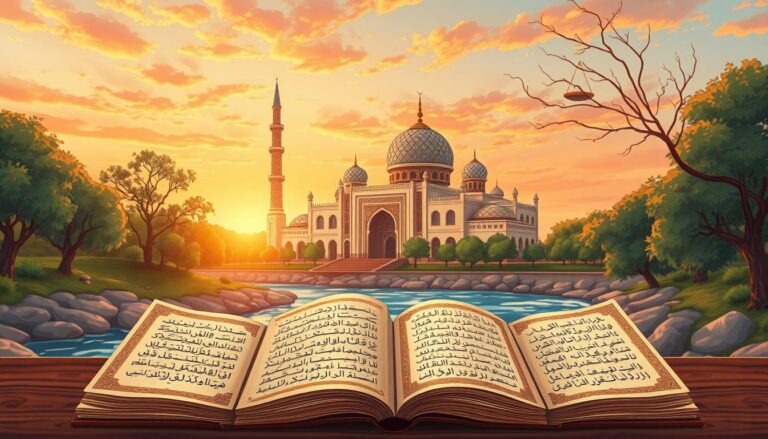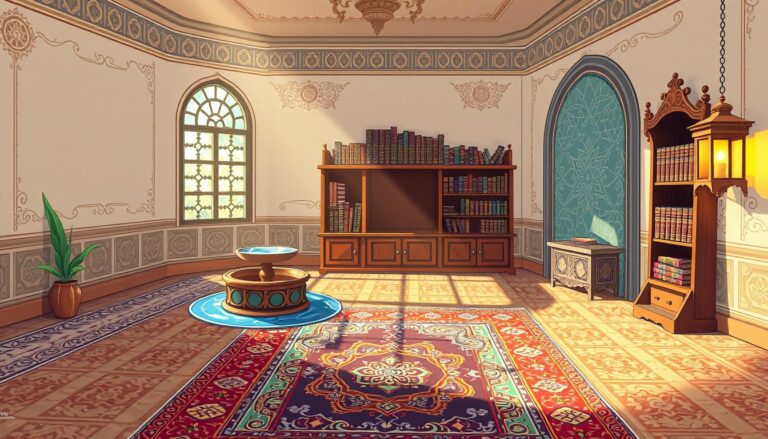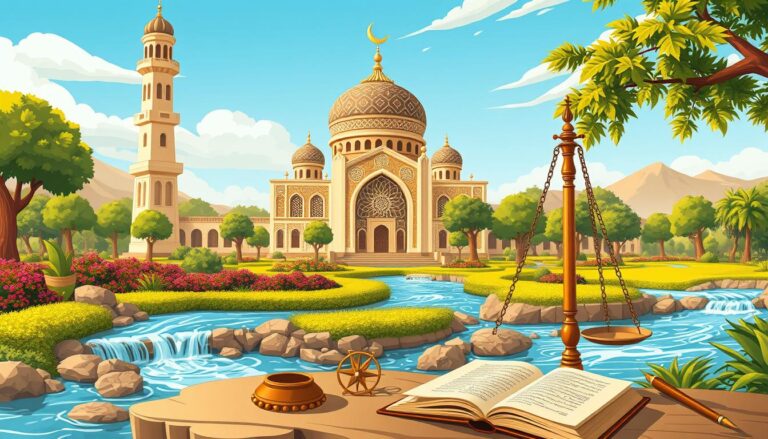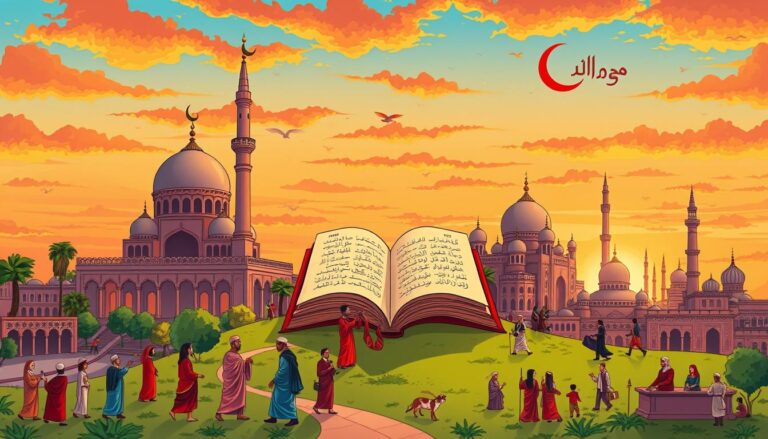Islamic Calligraphy Explained: Beyond Words and Letters
Ever wondered how a single Arabic letter can tell a story or stir deep emotions? Islamic calligraphy is an art that goes beyond just writing. It turns letters into visual poetry, mixing spirituality with beauty in a way that grabs both the eye and the soul.
Arabic calligraphy is a key part of Islamic art, dating back to the 7th century. It started as a way to preserve the Quran but soon became a treasured cultural gem. In 2022, UNESCO honored its importance by adding it to the Intangible Cultural Heritage list, showing its global value.
The beauty of Islamic calligraphy is its ability to transcend words and letters. Calligraphers spend years perfecting their craft, balancing form and meaning. They use colored inks on thick paper or card to create flowing, curved scripts that seem to move on the page. Each piece shows the calligrapher’s skill and dedication, often sharing complex ideas through a single, beautiful stroke.
Key Takeaways
- Islamic calligraphy transforms letters into visual art
- UNESCO recognized Arabic calligraphy as Intangible Cultural Heritage in 2022
- The art form originated from preserving the Quran
- Calligraphers use colored inks and special papers for their work
- Mastering calligraphy requires years of dedicated practice
- Each calligraphic piece balances form, meaning, and spirituality
The Origins and Evolution of Islamic Calligraphy
Islamic calligraphy started in the 7th century. It was a way to keep sacred texts, like the Quran, safe. This art showed the beauty of creation through detailed Arabic typography.
Early Development in the Islamic World
The start of Islamic calligraphy was tied to Islam’s rise. Early Arabic script was hard to read because it lacked important marks. By the 8th century, a special script for the Quran was created. It had bold lines and compact shapes.
Influence of Religious Texts on Calligraphic Styles
Quranic verses were key in calligraphy. The need for clear scripts led to different styles. Naskh was popular for its easy reading, while Thuluth was loved for its elegant curves.
Spread and Diversification Across Cultures
As Islam grew, new calligraphy styles emerged. In Iran, Persian and Nasta’liq scripts were known for their curves. North Africa’s Maghribi script had rounded shapes. Ottoman Turkey’s Diwani script was ornate.
Islamic calligraphy went beyond religious texts. It became a key part of mosque decorations. Mosques showed Quranic verses and geometric patterns, symbolizing divine perfection. Today, it blends old and new styles in modern works.
Fundamental Styles of Arabic Calligraphy
Arabic calligraphy has a long history with seven major styles. Each style has its own look and purpose. They show the culture and history of their time.
The Kufic script was used from the 7th to the 10th centuries. It’s found in old mosques and palaces from Spain to Iran. It was key in early Quranic manuscripts and later on tombstones, buildings, and coins.
The Thuluth script is smaller than others, named for being a third of the size. It became popular during the Umayyad period. Its curved letters and flowing style are seen in manuscripts, tombstones, and ceramics.
Naskh script was developed a century after Islam started. It’s used for writing the Quran. Its rounded and flowing form makes it great for writing large texts, making it a favorite among calligraphers.
Ottoman calligraphy brought the Dewani script in the 16th and 17th centuries. It was used until the 20th century. It shows how calligraphy styles have changed over time.
- Rayhani: An easily readable style named after a sweet-smelling plant
- Muhaqqaq: Considered one of the most beautiful forms, used for Quranic transcription
- Riqa: A modern style developed in the late 19th century, favored by Ottoman calligraphers
These styles show the beauty and variety of Arabic calligraphy. Each one adds to the rich Islamic art and culture.
The Art of Hilya: Portraying the Prophet Muhammad
Islamic art values calligraphy highly. The hilya is a special mix of Arabic calligraphy and Ottoman art. It’s a spiritual portrait of Prophet Muhammad, showing his essence through words, not images.
Definition and Significance of Hilya
Hilya means “ornament” in Arabic. It’s a calligraphic piece that describes the Prophet’s qualities. Since the 16th century, Ottoman Muslims have made these beautiful pieces to show their devotion.
They display hilyas in homes and workplaces. This honors Muhammad’s memory through Islamic art.
Components and Structure of Hilya Compositions
A typical hilya has several parts:
- Central text describing Muhammad’s attributes
- Quranic verses framing the main description
- Beautifully rendered Arabic calligraphy
- Ornate borders with floral or geometric designs
Historical Development of Hilya Art
The hilya tradition grew in the 17th century. Ottoman calligrapher Hâfiz Osman started its elaborate form. Today, artists like Rasheed Butt keep it fresh, adding colorful decorations and gold leaf.
This shows Islamic calligraphy’s lasting appeal. It can change while keeping its spiritual core.
The hilya stands as a testament to the power of words in Islamic art, offering a profound connection to the Prophet without relying on physical depictions.
Calligraphy as a Form of Spiritual Expression
Islamic art deeply roots in calligraphy. This ancient practice goes beyond writing, becoming a spiritual journey. Calligraphers write Quranic verses, creating works that transcend words and letters.
Creating Islamic calligraphy is like meditation. It requires focus, detail, and letting go of control. This lets practitioners connect with their inner selves, feeling a bond with the divine.
Calligraphy is the spiritual geometry of language.
Colors are key in calligraphic expression. Each color has its own energy and message:
- Red ignites passion
- Blue brings calmness
- Yellow radiates joy
- Green symbolizes growth
These colors connect with our subconscious, unlocking creativity and self-expression. The mix of colors and calligraphy forms a beautiful expression, conveying thoughts and feelings through elegant strokes.
Many find joy in Islamic calligraphy. It shows alignment with one’s purpose and intention. This art, rooted in Islamic tradition, is a powerful way to connect spiritually and discover oneself.
Islamic Calligraphy Explained: Beyond Words and Letters
Islamic calligraphy is more than just writing. It’s a blend of precision and art, especially with the Quran. Over 100 styles of Arabic typography have emerged, each with its own flair.
The Aesthetic Philosophy Behind Calligraphic Design
By the 8th century, a special way of writing the Qur’an was set. Calligraphers used different sizes, colors, and styles, following strict rules. Ibn Al-Bawwab created a system using square dots to measure letters, changing the art forever.
Symbolism and Meaning in Letter Forms
Over time, seven types of cursive script emerged: Naskh, Thuluth, Muhaqqaq, Rayhani, Tawqi, Riq’aa, and Nastaliq. Each has its own meaning. For instance, Thuluth is seen as the best, used for titles and decorations. Tawqi, meaning “signature,” was for signing important papers.
The Interplay of Text and Visual Art
Islamic calligraphy combines with geometric patterns and Arabesque designs. This mix creates a unique look that’s both beautiful and meaningful. The Hurufiyya movement, starting in Iraq in the 1940s, mixes old calligraphy with new styles, showing its flexibility.
Calligraphy is the geometry of the spirit.
Today, shows like “Beyond the Letter” at the Sharjah Museum of Islamic Civilization highlight calligraphy’s growth. These events feature famous artists worldwide, showing how Islamic calligraphy keeps evolving and inspiring today.
Tools and Techniques of Islamic Calligraphy
Islamic art and Arabic calligraphy go hand in hand. Over the centuries, the tools and techniques have changed. They show the deep culture of the Islamic world. From the qalam, a pen made from dried reed or bamboo, to the detailed styles of Arabic typography, each part is key to creating stunning works.
The qalam is the main tool for Islamic calligraphers. Its special cut makes smooth, flowing lines in Arabic script. Making ink is also crucial, as calligraphers mix their own to get the right consistency and color.
Each calligraphic style needs its own techniques. The Kufic script, from the 7th century, needs sharp angles and bold strokes. On the other hand, the Naskh script, from the 10th century, requires a more flowing style. The Thuluth script, known for its complex proportions, is a big challenge even for experts.
- Kufic: Bold, angular strokes
- Naskh: Fluid, cursive style
- Thuluth: Complex proportions
Calligraphers use extra techniques to make their work stand out. Using gold or colored ink adds beauty, and outlining letters adds depth. Some artists also put text on decorative backgrounds, mixing calligraphy with other Islamic art forms.
The materials used in Arabic calligraphy have changed over time. Early works were on parchment, leather, and wood. Now, paper and digital tools offer new ways to express art. This change keeps Islamic calligraphy alive and exciting today.
Calligraphy in Islamic Architecture and Decorative Arts
Islamic calligraphy is key in architecture and decorative arts. It started from Nabataean calligraphy and became a big part of Islamic design. It mixes with Islamic geometric patterns and Arabesque designs to create beautiful visuals in many places.
Integration of Calligraphy in Mosque Design
Mosques are a perfect mix of calligraphy and architecture. The Putrajaya Islamic Complex is a great example. It uses calligraphy, floral motifs, and geometric designs. These show the mix of different architectural styles.
Calligraphic Motifs in Ceramics and Textiles
Calligraphy is not just for architecture; it’s also in decorative arts. Ceramics and textiles often have detailed calligraphic designs. Arabic typography makes these items elegant, blending form and function well. The use of geometric, floral, and calligraphic patterns is common due to Islamic art’s rules.
The Role of Calligraphy in Manuscript Illumination
Manuscript illumination is a showcase of Islamic calligraphy’s beauty. By the 8th century, a unique Qur’an manuscript style was seen. Scribes used gold or colored lettering, outlined words, and decorative backgrounds. This tradition kept the art of handwritten calligraphy alive, even with the advent of mechanical printing in the late 19th century.
- Fluid script styles developed from the 13th century
- Calligraphy merged with floral and geometric patterns
- Handwritten texts remained important despite printing technology
The lasting charm of Islamic calligraphy in architecture and decorative arts shows its importance in Islamic culture and design.
Contemporary Applications of Islamic Calligraphy
Islamic calligraphy has grown beyond its old religious uses. It now plays a big role in modern design and branding. This ancient art, based on Arabic typography, is seen in logos and digital art. It shows the beauty of Islamic art, going beyond just words and letters.
Graphic designers use calligraphic styles like Riqa for modern projects. This script fits well with today’s sleek designs while keeping cultural ties. Big Arab brands, like Al Jazeera, use calligraphy in their logos, showing its lasting importance.
Digital artists are mixing calligraphy with technology in amazing ways. Their work often talks about identity, spirituality, and how we connect globally. It shows how Islamic art is a big part of today’s world.
“Calligraphy is the geometry of the soul expressed through the body.” – Anonymous calligrapher
Social media has given Islamic calligraphy a new stage. Artists share their work worldwide, inspiring a new crowd. Calligraphy videos on Instagram and TikTok get millions of views, showing its lasting charm.
- Logo design for modern brands
- Digital art and interactive installations
- Social media content and viral videos
- Fashion and textile design
As Islamic calligraphy keeps changing, it stays a key way to express and share culture. Its ability to fit into new forms while keeping its essence makes it a big part of today’s art scene.
Preserving the Tradition: Modern Calligraphy Schools and Masters
Islamic art is alive thanks to modern calligraphy schools and masters. These places are key in keeping Arabic calligraphy’s rich history alive. They also help bring new ideas to the field.
Prominent Calligraphy Institutions
Istanbul, the heart of the Ottoman Empire, is now a center for calligraphy students. People from all over come to learn from top masters. In the Ottoman school, teaching is seen as a gift. Masters share their knowledge for free, keeping the art’s sacred nature.
Notable Contemporary Calligraphers
Today’s calligraphy masters are shaping Islamic art. They follow a tradition started by Hafız Osman in the 17th century. When they sign their work, they honor their teachers, showing the art’s long history.
Fusion of Traditional and Modern Styles
Calligraphers today mix old techniques with new ideas. They use the qalam, a pen that symbolizes divine creation. But they also try out new mediums and styles. This mix keeps Arabic calligraphy alive and meaningful today.
“Calligraphy is the geometry of the soul expressed through the body.”
The art of Islamic calligraphy is always changing, linking the past to the present. It shows the lasting beauty and importance of this tradition in Islamic art.
Conclusion
Islamic calligraphy is a powerful mix of art and faith. It started in the 7th century Middle East and has grown a lot. The Naskh script and Thuluth style show how Arabic typography has evolved.
This art is more than just words and letters. It beautifies homes and offices, bringing calm and positive vibes. Every year, international exhibitions celebrate Arabic calligraphers from around the world. It keeps Islamic teachings alive and shares divine wisdom.
Looking ahead, Islamic calligraphy will keep growing. It connects old traditions with new ideas. From Ibn Muqlah’s precision to Sufi philosophy’s mysticism, it continues to inspire and amaze people of all ages.
Source Links
- Calligraphy in Islamic art · V&A
- Beyond Words: Hilyas in Islamic Calligraphy
- Calligraphy in Islamic art · V&A
- Qur’anic History and the Role of Islamic Calligraphy
- Islamic calligraphy | Islamic World Class Notes | Fiveable
- A guide to the seven styles of Arabic calligraphy
- Islamic calligraphy
- Arabic Calligraphy – Taking A Closer Look
- Layout of the Hilya – Damas Cultural Society
- Depictions of Muhammad
- Arabic Calligraphy: A Spiritual Art
- Celebrating Arabic Calligraphy — The Creative Process
- Calligraphy in Islamic art · V&A
- The Art of Islamic Calligraphy
- Beyond the Letter: Modern Arabic Calligraphy from the Collection of The Islamic Arts Museum Malaysia
- Calligraphy in Islamic art · V&A
- Islamic Calligraphy
- Calligraphy in Islamic art · V&A
- The Islamic art and design elements applied in the Islamic city – City, Territory and Architecture
- Significance of Arabic Calligraphy in the Evolution of Islamic Art – Al-dirassa – Best Online Arabic,Islamic Programs and Holy Quran
- MergedFile
- The Art of Islamic Calligraphy: Rituals and Traditional Art – Maydan
- Arabic calligraphy: Ancient craft, modern art
- Calligraphy: The Art of Calligraphy: History, Practice, and Modern Relevance
- The History of Arabic Calligraphy
- Calligraphy as Identity: Defining Arabness in Script







